
Figure 1.--Kleine Frans (Little Frans) wears a smock called a "kinderpakje" which required some setailed sewing work. Click on the image for a pattern of the detailing. The dark box is red and the crossed box is blue

The smock patterns had elaborate information and instructions concerning the detailing on the smocks. While garments were rather basic, the detailing coukd require quite a bit of work. There were so many smock styles that there were quite a range of detailing involved. The Dutch term for these outfits is pakje. "Kinder" means child as does "jogens". HBC beloeves, however, that both garments were for boys as they are shown worn with short pants. In the 1920s it was noy yet considered suitable for girls to wear short pants.
One smock for a 2-4 year old boy was kalled a "kinderpakje" (child???). The smock was white with red and blue needed work. It is a very short smockm rather like a tunic jacket worn with short pants. Like many Durch smocks there is a belting arrangement, in this case a string arrangement which hangs at the dide like a sash. The smock has short sleeves and a an arrangement at the front where the smock was slipped on. There is detailing at the front, sleeves, and hems.
The instructiones read, "Kleine Frans' kielpakje is van afgedeelde witte stof met kruissteekversiering van rood en blauw, [the dark box is red and the crossed box is blue]. Ontwerp van Jettie de Bordesvan Alderwerelt van Rposenburgh. De dwarse gearceerde lijntjes op Nr. A aan weerszijden van het split zijn gaatjes voor het koordje. De rand onderaan loopt langs mouwtjes en kielzoom. Het losse motiefje zit op de lippen voor het ceintuurkoord. Prijs patroon kieltje en broekje 2-4 jaar 60 ct. + 15 ct." port.
Another 1922 Dutch smock pattern is labeled "Jongenspakje met Vorkhaaksel". I'm not sure what that means in English. The smock is the more traditional European style, cut well below the waist and with long sleeves. It is white with colored trim at the collar, cuff, and belt which strangely is not connected at the front. There are two parallel lines of knitted trim. I'm not sure how this smock was put on. There may be buttons at the back. There is no indication at this time as to just what age for which this smock was made. It looks to be worn with short pants, although they could be knickers bloused above the knee--the image is not destinct. These shorts are a contrasting color rather than the matching color like the smock pictured above. Note that the drawing shows the child wearing rather old fashioned shoes.
There are three figures on the magazine page for this smock. Figure 1 (Afb. 1) reads "Werkwijze van vork- of guimpehaken." This appears how to knit the decorative detail. Figure 2 (Afb. 2) "Tusschenzetsel in het kieltje." This shows how the decorative detail is worked into the garment. Figure 3 (Afb. 3) "Jongenspakje met vorkhaaksel." This is a full drrawing of how this smock outfit would look.

Figure 2.--This smock was referred to as a "Jongenspakje met Vorkhaaksel". Note thatvlike many Dutch smocks for boys that there is a belting arrangement. |
Navigate the Boys' Historical Clothing Web Site:
[Return to the Main Dutch 1920s smock page]
[Return to the Main national smock page]
[Introduction]
[Activities]
[Bibliographies]
[Biographies]
[Chronology]
[Clothing styles]
[Contributions]
[Countries]
[Boys' Clothing Home]
Navigate the Boys' Historical Clothing Dutch pages:
[Return to the Main Dutch boys clothing page]
[Maiken Island]
[Dutch choirs]
[Dutch royalty]
[Dutch scouts]
[Dutch school uniform]
[Dutch boys bangs]
Navigate the Boys' Historical Clothing national pages:
[Return to the Main countries page]
[Australia]
[Belgium]
[England]
[France]
[Germany]
[Ireland]
[Italy]
[Japan]
[Korea]
[Mexico]
[Netherlands]
[Scotland]
[United States]
